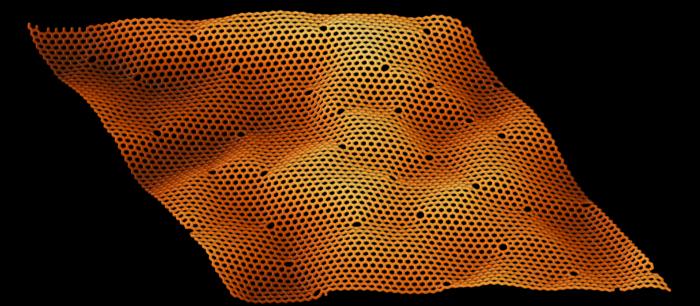In recent years, the exploration of two-dimensional (2D) materials has brought forth transformative possibilities in numerous technological fields. Among these materials, graphene—a sheet of carbon atoms arranged in a hexagonal lattice—has emerged as a remarkable subject of study due to its extraordinary properties. Graphene is widely recognized for its high electrical and thermal conductivity, exceptional strength, and remarkable flexibility. However, recent research highlights the critical influence of defects on the rippling behavior of graphene sheets, revealing a complex relationship that can significantly affect their properties and applications.
Defects within graphene, which can arise during synthesis or fabrication processes, play a pivotal role in defining how the material behaves on an atomic scale. This interaction between defects and material properties is a focal point of ongoing research, underscoring the necessity to comprehensively understand how these imperfections alter the rippling dynamics of graphene. Ripples are not mere surface phenomena; they substantially impact graphene’s mechanical strength, chemical reactivity, and electrical conductivity. As the demand for advanced materials in flexible electronics, energy storage systems, and catalytic processes continues to soar, understanding the nuances of ripples induced by defects becomes paramount.
The latest study, which involved a collaborative effort from several prestigious institutions, employed machine learning techniques to create accurate computational models for studying the rippling behavior of defect-laden graphene. This innovative application of artificial intelligence enables researchers to simulate the dynamics of rippling at an atomic level, providing insights that conventional experimental methods struggle to capture. By analyzing these simulated interactions, the researchers discovered that the introduction of defects disrupts the movement of ripples, leading to unexpected consequences for the overall flexibility and performance of the material.
A particularly striking finding from this research is that at higher concentrations of defects, graphene membranes can become effectively “frozen,” leading to a drastic reduction in flexibility. This phenomenon suggests that while defects might traditionally be viewed as unwanted characteristics in materials, they harbor the potential for innovative design strategies. By leveraging the behavior of defects, engineers can tailor the properties of graphene for specific applications, turning potential liabilities into design opportunities.
The research team, led by Dr. Fabian Thiemann, articulated the significance of their findings, emphasizing the importance of bridging the gap between experimental observations and atomic-scale simulations. As PhD researchers transitioning into positions in academia and industry, Thiemann and his colleagues are positioned to make considerable contributions to the field of materials science as they further explore the implications of defect-driven rippling. Their work exemplifies the transformative potential of combining advanced computational techniques with empirical research.
Moreover, the implications of this research extend beyond graphene, as the methodologies established could be applied to a variety of 2D materials. The manipulation of rippling and defects could pave the way for designing new materials that harness the unique properties of other elemental sheets, opening doors to applications in various high-tech domains, including nanotechnology, nanofluidics, and beyond. By refining our understanding of defects and ripples, scientists and engineers can create materials with enhanced functionalities for energy-efficient electronics and beyond.
In reflecting on the future of this research, the team expresses optimism about further investigations into the interactions between 2D materials and their environments. Future studies will likely explore how these membranes behave in more complex settings, interacting with liquids and other materials. Such inquiries promise to uncover new dimensions of material behavior, presenting both challenges and opportunities for the field of materials science.
As researchers continue to push the boundaries of understanding in this arena, an exciting aspect is the growing integration of interdisciplinary approaches combining physics, chemistry, and engineering. The convergence of these fields is particularly vital in the context of developing advanced materials tailored for specific uses. Additionally, it accelerates materials discovery, allowing scientists to design and synthesize new compounds with desired characteristics, thereby laying the foundation for the next generation of technological advancements.
Critical to the advancement of this research is the collaboration between institutions, merging diverse expertise and perspectives for maximum impact. The team’s positive acknowledgment of collaborative efforts reflects a broader trend within the scientific community where researchers are increasingly recognizing the value of pooling resources and insights to solve complex problems. This collaborative spirit is especially prominent in the context of machine learning applications, where interdisciplinary teams can generate richer datasets and more robust predictive models.
Ultimately, this research sets a significant precedent in understanding the role of defects in two-dimensional materials, especially graphene. By unraveling the complexities of rippling and defects, scientists can harness these insights to bolster material applications across various technological fields. As researchers lay the groundwork for innovative applications, the future landscape of materials science is poised for substantial transformation, with profound implications for technology and industry alike.
The interplay of defects and dynamic rippling in materials like graphene heralds a new era of engineering design, where scientists can manipulate the seemingly undesirable to create breakthrough applications. As the field moves forward, continual innovation and collaboration will likely unveil new ways to utilize 2D materials, charting paths toward more advanced and efficient technologies.
In summary, the examination of defects in graphene exemplifies how understanding fundamental material properties leads to transformative opportunities across various tech industries. By embracing and investigating the complexities of rippling influenced by defects, researchers are on the cusp of revolutionizing material applications for tomorrow’s advanced technology landscape, paving the way for innovative breakthroughs and applications that will reshape our interaction with materials in myriad ways.
Subject of Research: Defects in Graphene and Their Impact on Surface Rippling
Article Title: Defects induce phase transition from dynamic to static rippling in graphene
News Publication Date: 28-Feb-2025
Web References: http://dx.doi.org/10.1073/pnas.2416932122
References: [Pending publication references must be specified]
Image Credits: Credit: Dr Camille Scalliet
Keywords
Tags: advanced materials for flexible electronicsapplications of graphene in technologychemical reactivity of grapheneelectrical conductivity in graphenegraphene defect impactgraphene mechanical propertiesgraphene synthesis challengesinfluence of defects on graphenemachine learning in material scienceripple patterns in graphenerippling behavior in nanomaterialstwo-dimensional materials research





